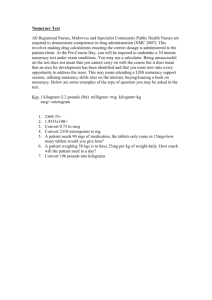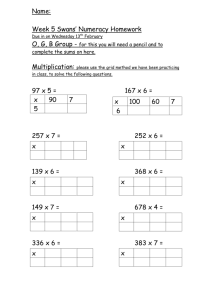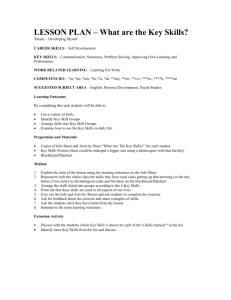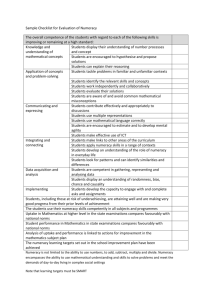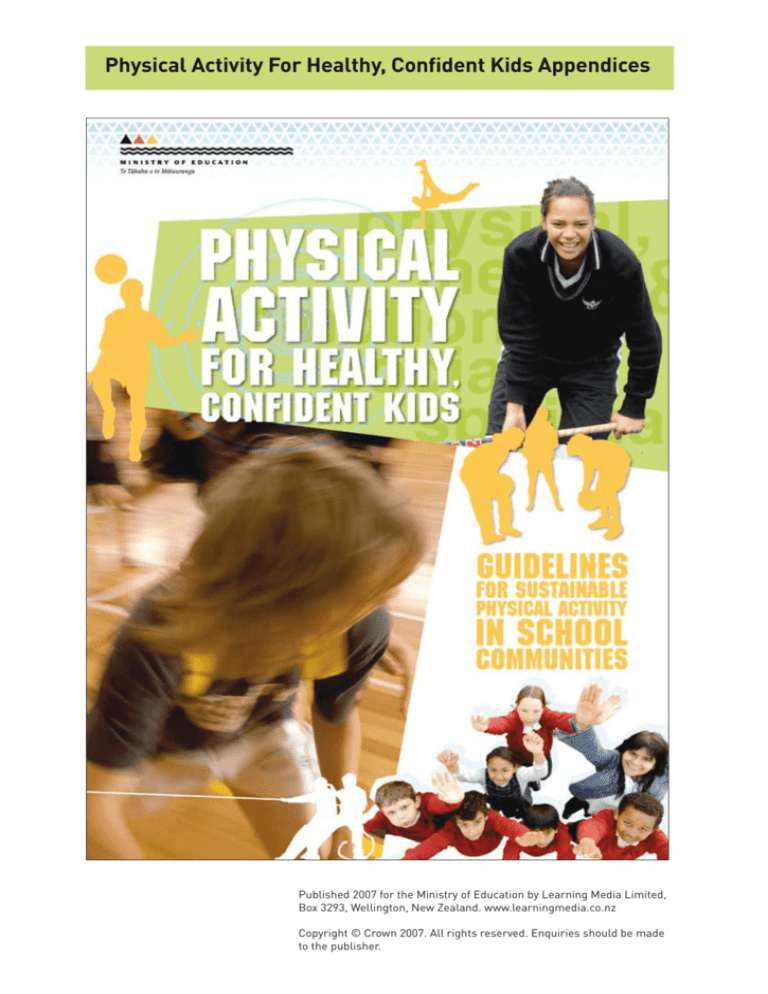
Physical Activity For Healthy, Confident Kids Appendices
Published 2007 for the Ministry of Education by Learning Media Limited,
Box 3293, Wellington, New Zealand. www.learningmedia.co.nz
Copyright © Crown 2007. All rights reserved. Enquiries should be made
to the publisher.
Appendix 5: Examples of Strategic Plans That Include
Physical Activity
Strategic Achievement Goals 2005–2008
Goal Two: Physical Activity
To develop a positive physical activity culture at Tasman School
Historical Overview
Tasman School has always prided itself on how physically active our students are and our
success on the sports field. In recent times it has been noted that students are choosing
more sedentary activities in their break times and we are getting fewer children actively
involved in sport or getting involved then pulling out when it seems to get too hard.
These factors, along with sedentary activities at home, such as watching TV and playing
computer games, and a growing number of clearly overweight students, have led to our
targeting physical activity as part of our 2006–2008 Strategic Plan. Clearly our needs are
not as great as other urban schools, but we feel that if we can put our plan in place early,
we will have more chance to change attitudes before they become too established and
widespread, and we can create a school culture where physical activity is seen as fun and
as an important part of a healthy lifestyle. It is something that everyone can access
and enjoy.
34
Student Achievement Target:
Action Plan 2006
Strategic Goal: Physical Activity
To develop a physical activity culture within our school
community
Annual Target:
That an identified group of inactive students will spend
at least 50% of their break-time participating in physical
activity.
Historical Position: A group of students were identified
as being physically inactive by staff, and a physical
activity study carried out in late 2006 confirmed that this
group was indeed quite inactive. During break-time, this
group was inactive 66% of the time. This is of concern
as international research shows clear links between
physical activity and student achievement. (Refer
to the full physical activity project report for further
information.)
Target Area:
Inactivity in break-time
Student group: (Circle)
Gender:
M
Ethnicity: All
F
All
Maori Other
Student Year: All Y1
Y2 Y3 Y4 Y5 Y6 Y7 Y8
Action Plan
Action
Time frame
Responsibility
Paul
Don
Resources
To carry out a detailed lifestyle
survey of identified inactive
students and create a physical
activity profile for each of these
children.
By the end of
term 1
Active sports
co-ordinator.
Staff to develop and teach a
school-wide unit in playground
games.
Weeks 5 to 10
term 1
All staff
Purchase more playground
equipment and court markings
to provide more of a variety of
activities for students.
By the start of
term 2
Paul
Don
Lead teacher professional
development – physical activity
project.
By end of term 2
Full-staff professional
development led by physical
activity lead teacher and
supported by PE adviser.
By end of the year
Paul – lead
All other staff
Staff meeting time
allocated
Perceptual motor programme in
years 1–3 to develop motor skills
at the lower end of the school.
By end of term 2
Jude and Fraser
Year 7–8 students
to assist
Parents
Lee Corlett
QCAPESS website
QCAPESS website
ChCh COE PE adviser
Budget in physical
activity area: $1500
Sports Distributors
Paul
Budget in physical
activity area: $1500
ChCh COE PE adviser
35
Budget in physical
activity area: $1500
Note: In previous charters, Tasman School has included a three-year overview. This is no longer
the case as we see our strategic plan as an evolving document and the outcomes of each year will
determine the targets for the following year.
Charter, Strategic and Operational Plans Development Process
2006–2008
September 2005
Strategic survey of parents, staff, and BOT
October 2005
Results are reported to BOT and Strategic Planning Sub-committee formed.
First strategic planning meeting held.
Staff decide on target areas.
Data is collected on the 2005 achievement target areas.
November 2005
School priorities developed and consultation carried out with the school community.
Staff carry out assessments for baseline data.
Some data is presented to BOT – Physical activity.
Information on 2005 Target areas presented to the BOT.
December 2005
Final baseline data is presented to the BOT – Boys’ education and numeracy.
Staff work with AtoL facilitator to develop some action plans.
January 2006
Staff develop all action plans for annual targets.
February 2006
BOT approves final charter.
Charter is sent to MOE.
Final charter is presented to parents at the “meet the teachers” evening.
BOT 2005 analysis of variance and information sent to MOE.
36
TARADALE PRIMARY
SCHOOL
Profile No. 2688
CHARTER: 2006-07
Mission Statement:
To prepare our children for lifelong
learning by developing their social,
intellectual and physical skills
in a creative and caring environment.
37
TARADALE PRIMARY SCHOOL
MISSION STATEMENT: ‘To prepare our children for lifelong learning by developing
their social, intellectual and physical skills in a creative and caring environment’
Long Term Planning:
NAG#1 Curriculum
NAG#2 Self Review
NAG#3 Personnel
NAG#4 Property
NAG#4 Finance
NAG#5 Health & Safety
NAG#6 Legislation
Charter:
Strategic
Goals/Plans
3 - 5 Years
Action Plans for:
Business as
Usual (BaU)
Consider:
• National Education Goals
• National Priorities
• Community Expectations
New Zealand’s
Cultural Diversity
ANNUAL TARGETS SET:
Literacy Numeracy Physical Activity
Devising & Implementation
ANNUAL PLAN
School Vision
Statement
Charter:
Strategic
Goals/Plans
3 - 5 Years
Action Plans for:
Raising Student
Achievement
(RSA)
Planning & Reporting
Principal’s
Reports to
Board of
Trustees
Annually
Monthly
38
Financial
Statements
prepared and
audited
TARADALE PRIMARY SCHOOL
Analysis of Variance: For the year ended 31 December 2006
Strategic Target: Physical activity
Strategic Goal:
To have raised the profile of physical activity within the school and the community by the end of
Term 4, 2006 as part of our involvement in the Physical Activity Initiative.
Target
(Charter: 2006)
•
•
•
As part of our
involvement in the
MOE Physical Activity
Initiative (Massey
University, Sport
HB, and Taradale
Primary School), we
have an agreement
to ensure that there
is a positive physical
activity culture within
Taradale Primary
School.
Michelle Lacey (Sport
HB) and Vicky Small
(Massey University)
will be working with
all staff as part of
our Physical Activity
Contract and will
be supporting us as
teams, individuals,
and as a whole staff
throughout the year.
Focus Groups: Years
0/1–6, both genders,
and all ethnic groups.
Outcome
(What Happened?)
Analysis
Evaluation
(Now What?)
Team Quotes
The data collected by
both the PA Advisers
and our own lead team
certainly confirms that
we are under way in
developing a positive
school community
physical activity
culture.
We have been informed
that we will continue
to be part of the Active
Schools Programme in
2007.
Team 1: There was a
definite improvement
in enthusiasm towards
PA with the children
doing physical
activities that they had
not previously tried.
Team 2: Ideas for PA
games and activities
provided through
the lead team and
PD proved to be very
helpful, practical, and
easy to use by staff.
“Push-Play” involving
the school and the
community proved
great in raising PA
awareness.
Team 3: More
equipment has
been a very positive
addition. Many more
opportunities for PA
at both lunch- and
playtimes. Children
love physical activity.
An analysis of what
is now happening
in the playground
certainly showed that
more students are
making better use of
the sports equipment
that is being provided,
especially from the
new sports trolley.
Another outcome
of this has been the
decrease in behaviour
problems in the playground.
39
We will continue with
the programme of
PD that has been
co-ordinated by the PA
advisers as well as our
own lead team.
As part of our
programme in 2007,
there will be a schoolwide focus on swimming
and/or aquatics which
will be linked into our
formative assessment
programme.
The lead team would
like to establish a sports
council of children
to consult with and
to discuss further
developments of our
school PA programme.
TARADALE PRIMARY SCHOOL
Analysis of Variance: For the year ended 31 December 2007
Strategic Target: Physical activity
Strategic Goal:
To continue to have raised further the profile of physical activity within the school and the
community by the end of Term 4, 2007 as part of our involvement in the SCPAP Initiative.
Target
(Charter: 2007)
Outcome
(What Happened?)
Analysis
• As part of our
continued
involvement in the
SCPAP Physical
Activity Initiative, we
have an agreement
to ensure that there
is a positive physical
activity culture
developed within
Taradale Primary
School.
• Michelle Lacey
(Sport HB) and
Nick Hendrickson
(Massey University)
will continue to
work with all staff
individually, as well
as with our three
teams throughout
the school year to
further develop a
positive physical
activity culture.
• Focus Groups: Years
0/1–Year 6, both
genders, and all
ethnic groups.
• Specific Focus Area:
Swimming and
aquatics.
40
Evaluation
(Now What?)
TARADALE PRIMARY SCHOOL
STRATEGIC TARGETS 2007: LITERACY, NUMERACY, AND PHYSICAL ACTIVITY
Strategic Target 1: Literacy: Written Language
Strategic Goal:
•
To raise the written language achievement of our students across the curriculum, with a
particular focus on improving writing conventions (surface and deeper features). Refer to: TPS
Written Language Matrix.
•
To increase written word power – spelling (surface features), and improving the quality of all
written work.
•
By the end of 2007, 80% of all year 6 students will be meeting or exceeding expectations in
word power – spelling. This will be reflected in all of their written work.
•
Focus Group: Year 6
•
Gender: Both
•
Ethnicity: All
•
Specific Focus Area: Spelling
Strategic Target 2: Numeracy
Strategic Goal:
•
To raise the numeracy achievement of our students across all year levels (NumP: Numeracy
Project).
•
By the end of 2007, 85% of all year 3 and year 5 students will be achieving at or above
expectations in subtraction.
•
Focus Group: Year 3 and year 5
•
Gender: Both
•
Ethnicity: All
•
Specific Focus Area: Subtraction
Strategic Target 3: Physical Activity
Strategic Goal:
•
To continue to have further raised the profile of physical activity within the school and the
community by the end of Term 4, 2007 as part of our involvement in the SCPAP Initiative.
•
To further develop a positive physical activity culture in the area of swimming and aquatics as
part of our school-wide swimming programme.
•
Focus Groups: Years 0/1–Year 6
•
Gender: Both
•
Ethnicity: All
•
Specific Focus Area: Swimming and aquatics
41
Target Areas for 2007
Two of the three target areas for 2007 are a continuation of the particular targets that we had set
for 2006.
The first target (Written Language) has come about following our school-wide focus on written
language as part of our involvement in the AtoL contract with Anna Stephenson. Anna will be
spending time with us throughout the year working with the lead team, individual teachers, and team
clusters, as well as taking a series of full-staff meetings.
Analysis of the 2006 IRAE data identified that only 63% of year 5 pupils were achieving at or above our
expectations for spelling. Pupils often knew how to spell words, but this knowledge was not reflected
in their written work. In fact, it was agreed to closely monitor all children in years 3, 4, and 6 as well
as our focus group: year 5, in regard to the Joy Allcock spelling programme.
The second target (numeracy) has been continued into 2007 as we will be again working with Dinah
Harvey as part of our school-wide numeracy contract with Advisers Plus. Dinah will be spending time
with us throughout the year working with individual teachers, and team clusters, as well as taking a
series of full-staff meetings (one per term).
Analysis of 2006 NumP (Numeracy Project) end-of-year project testing data identified that 82% of year
2s were achieving at or above our expectation.
At expectation: 44% (Boys: 11%, Girls: 33%)
Above expectation: 38% (Boys: 23%, Girls: 15%)
The area of concern was to do with subtraction. It was agreed that we will closely monitor our year 3s
and year 5s during 2007.
The third target (physical activity) has been introduced in 2007 as part of our continued involvement in
the SCPAP Physical Activity Initiative (started in 2006) with four other schools in Hawke’s Bay (and 59
other schools in New Zealand). All schools involved in this contract have signed an agreement with
SCPAP to ensure that we are working on developing and further raising a positive physical activity
culture.
Michelle Lacey (Sport HB) and Nick Hendrickson (Massey University) will continue to work with all
staff individually, as well as with our three teams throughout the school year to further develop a
positive physical activity culture. They will also be involved in taking a series of full-staff meetings with
a particular focus on physical activity in the classroom, the school, and the school community, as well
as using formative assessment strategies (learning intentions, success criteria, feedback, and feedforward) within our class physical education programmes.
At this stage, I feel that the same three target areas will continue into 2008, but there may have to
be some minor changes regarding focus year-groups based on the end-of-year data we collect when
evaluating each of the three targets for 2007. This will, however, be confirmed at the beginning of the
2008 school year.
Allen McMillan
Principal
February 2007
42

